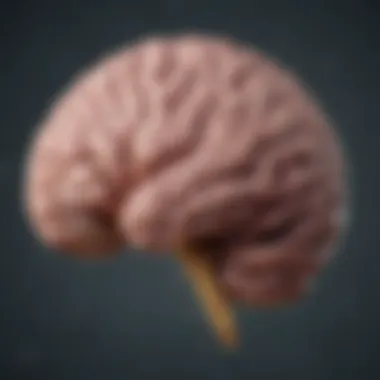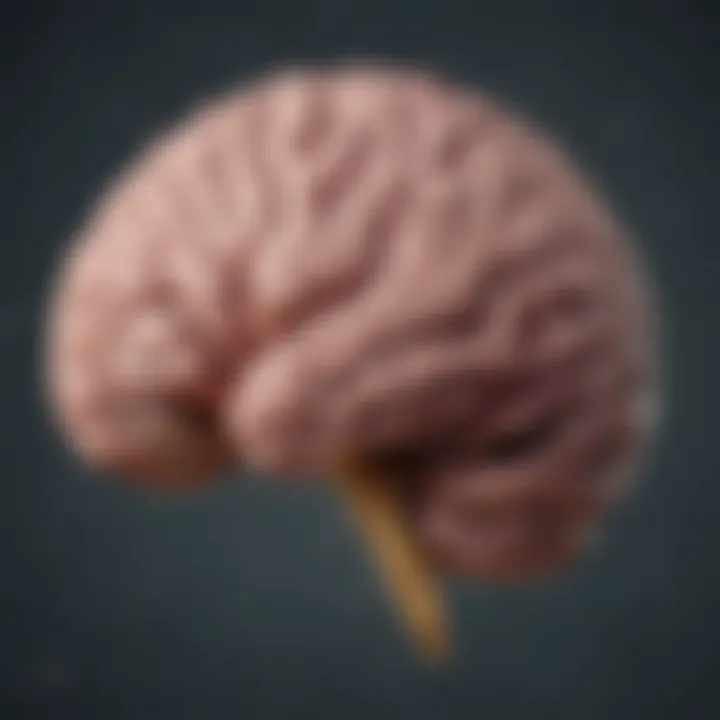Neuroscience and Its Impact on Human Behavior


Intro
Understanding how our brain influences behavior is a fascinating journey into the realm of neuroscience. It's not merely about identifying actions or reactions but digging deep into the neural circuits and processes that guide our every move. Human behavior is complex, interwoven with both biological foundations and environmental influences. The aim of this exploration is to paint a clearer picture of the synergy between neurobiology and our behavioral patterns.
Research Context
Background and Rationale
For many years, the interplay between neural functioning and behavioral responses has captured the interest of scientists and psychologists alike. Advances in neuroscience have opened new doors in comprehending how various brain regions interact to shape behaviors, thoughts, and even emotions. This investigation is vital; it sheds light on both typical behavior and the disturbances observed in various psychological disorders.
Choosing to study this relationship stems from a pressing need in modern psychology to understand the biological basis behind actions. As society grapples with issues like mental health, understanding neural mechanics offers not just insight but potentially solutions to behavior-related challenges.
Literature Review
Several studies have sought to map the intricacies of the brain and its functionalities. Research highlights the role of specific structures, such as the amygdala in handling emotional responses and the prefrontal cortex in decision-making and impulse control. These insights serve as a foundation for further exploration into how these areas collaborate or sometimes conflict during complex interactions.
Publications reveal a growing body of empirical evidence that correlates changes in brain activity with distinct behavioral outcomes. For example:
- Neuroscientific findings indicate how emotional regulation is a function of ongoing activity in neural networks.
- Investigations into neuroplasticity show how experiences can reshape brain pathways, thus altering behavior over time.
Engaging with this literature is vital for grounding our understanding in established research while paving the way for new inquiries.
Methodology
Research Design
A multi-method approach seems most effective in studying the neural underpinnings of behavior. Combining qualitative examinations with quantitative data brings forth a comprehensive landscape of how behavior is both expressed and modified within different contexts. Conducting longitudinal studies allows researchers to observe behavioral patterns over time, emphasizing the influence of underlying neural mechanisms.
Data Collection Methods
Various methods contribute to this rich data tapestry. Observational studies enable one-on-one understanding of actual behaviors, while brain imaging technologies, such as fMRI and EEG, allow for a glimpse into real-time brain activity reacting to specific stimuli. These methods collectively provide a well-rounded narrative on how behaviors arise from neural architecture.
"There is no ability more fundamental to human existence than our capacity to learn and adapt. Therefore, understanding the brain's role in behavior is not just academic; it is foundational to our very humanity."
Ultimately, the exploration of neuroscience and behavior can improve educational approaches, therapeutic interventions, and even policy-making aimed at enhancing mental health. This journey leads us to appreciate that behavior is not just an isolated event but a complex interplay of biological, psychological, and social factors, laying the groundwork for future discussions in this essential field.
Prolusion
The exploration of the relationship between neuroscience and behavior has become increasingly vital in understanding the complexities of human actions. This article aims to dissect the intricate neural mechanisms that influence how we think, feel, and behave. By delving into various brain structures and processes, we uncover how our neural makeup shapes our everyday experiences.
Understanding this relationship offers multiple benefits. It can help in identifying the biological roots of behavioral patterns, shed light on the mechanisms behind psychological disorders, and inform therapeutic approaches. The implications are far-reaching—from improving mental health interventions to enhancing educational methodologies.
Moreover, recognizing the interplay between different disciplines, such as psychology, biology, and sociology, enriches our understanding of behavior.
The importance of examining these topics cannot be overstated. The impact of neuroscience on behavior influences not just individual lives but society as a whole. Neurological insights pave the way for developing targeted strategies to address mental health issues and encourage positive social behavior.
"The mind is a mirror, reflecting the workings of the brain; to understand the mind, we must first explore its neural underpinnings."
Through this article, we will establish a foundational understanding of the components that link our neural architecture to behavioral outcomes.
Foundational Concepts
The exploration of neuroscience and behavior requires a close examination of foundational concepts, which directly influence our understanding of the various neural underpinnings that dictate human actions, thoughts, and social interactions. Recognizing how neurons function and the brain structures involved in behavior is essential for grasping the complexity of this field. Here, we break down these topics to reveal their significance in the context of behavior.
Neurons and Their Functions
Neurons stand as the fundamental building blocks of the nervous system. They are specialized cells responsible for transmitting information throughout the body. Each neuron is designed to communicate via electrical impulses and chemical signals. This process facilitates rapid communication, forming networks that underlie all behaviors.
A critical aspect of neurons is that they can adapt based on experiences, a phenomenon known as neuroplasticity. This allows the brain to evolve and reorganize itself, enhancing learning and memory. The intricate wiring and synaptic connections form a matrix that is not static but a dynamic interplay, reflecting the ongoing learning and the impact of environment on behavior. Understanding these functions paints a clearer picture of why behavior can change over time and how it can be influenced by various factors.
Brain Structures Involved in Behavior
Hippocampus and Memory
The hippocampus plays a pivotal role in memory formation. Its specific contribution lies in the encoding and retrieval of memories. A key characteristic of the hippocampus is its involvement in both declarative memory and spatial navigation. This makes it a crucial component for understanding the relationship between memory and behavior. It’s noteworthy that damage to this structure can lead to significant memory deficits, emphasizing why it is often highlighted in behavior studies.
The unique feature of the hippocampus is its capacity for neurogenesis, which is the generation of new neurons. This characteristic offers a potential advantage when considering treatments for memory-related disorders. Understanding how the hippocampus operates provides insights into strategies that could help improve memory functions, ultimately contributing to better mental health outcomes.
Amygdala and Emotion Regulation
The amygdala is essential for emotion regulation, particularly in processing fear and pleasure. Its role in recognizing threats and influencing emotional responses makes it a topic of interest in behavioral neuroscience. A highlighted characteristic is the amygdala's connection with other brain regions, such as the prefrontal cortex, which assists in modulating emotional responses based on context and rational thought.


One unique aspect of the amygdala is its ability to create emotional memories, which can have lasting effects on behavior. This can be both beneficial and disadvantageous; while it aids survival by remembering threats, it can also contribute to anxiety disorders if those memories become overwhelming. Understanding these dynamics is crucial for developing interventions aimed at emotional regulation and therapy.
Prefrontal Cortex and Decision Making
The prefrontal cortex plays a vital role in decision-making processes, problem-solving, and self-regulation. Its key characteristic is the ability to integrate information from various other brain regions to make informed decisions. This feature is essential for understanding complex behavioral patterns and rational thought processes.
One unique aspect here is the concept of executive functions, which include planning, inhibition, and cognitive flexibility. These functions are vital for adapting to new situations and challenges. However, impairments in the prefrontal cortex can lead to impulsivity and poor decision-making, highlighting the significance of this structure in both normal and abnormal behaviors.
Learning about the prefrontal cortex reinforces the connection between brain health and behavioral outcomes, making it a crucial topic in neuroscience research.
Neural Mechanisms of Behavior
The neural mechanisms of behavior form a cornerstone in understanding how our brains drive actions, thoughts, and emotions. This segment emphasizes the complex interplay between neurons, brain structures, and various chemical agents that facilitate every human experience. Comprehending these mechanisms is key for students, researchers, and professionals who aim to decode the biological factors of behavior, shed light on psychological disorders, and contribute to therapeutic advancements.
Neural mechanisms connect cognition to behavior, showing us how thinking influences actions. Activities ranging from simple reflexes to intricate social interactions involve highly coordinated neural operations. Moreover, recognizing the neural underpinnings can lead to breakthroughs in addressing mental health issues, making it a significant area of focus for future investigations.
Synaptic Transmission and Plasticity
Synaptic transmission and plasticity are fundamental to how our nervous system communicates. When neurons transmit signals across synapses, it lays the groundwork for all behavior. This process isn't just about sending messages; it’s also about learning and adaptation. Neuroplasticity refers to the brain's ability to change and adapt as a result of experience, which is crucial in forming memories and learning new skills. Synaptic strength can vary based on how frequently certain pathways are activated, highlighting the dynamic nature of our brain's architecture.
Understanding this aspect of neuroscience helps us grasp how habits are formed or how traumatic experiences can alter behavior. For example, a person who repeatedly undergoes stress may develop new neural pathways that predispose them to anxiety, illustrating the profound impact synaptic plasticity can have.
The Role of Neurotransmitters
Neurotransmitters are the brain's chemical messengers. They facilitate communication between neurons, impacting everything from mood to cognition. Each neurotransmitter has distinct roles, influencing how we feel and behave. Focusing on key neurotransmitters like dopamine, serotonin, and acetylcholine reveals their critical contributions within the broader framework of this study.
Dopamine and Reward
Dopamine plays a pivotal role in the reward system of the brain, reinforcing behaviors that are essential for survival, such as eating and reproduction. When an individual engages in a behavior that leads to pleasurable outcomes, dopamine is released, acting like a natural reward that encourages repetition of that behavior. In a way, it acts as a motivator, pushing us toward experiences that bring satisfaction. The key characteristic of dopamine is its association with pleasure and reward; this quality makes it a compelling subject for examining the neural mechanisms of behavior.
However, an overactive dopamine system can lead to issues such as addiction or compulsive behaviors, while deficiencies can manifest as lack of motivation or anhedonia. This duality illustrates why dopamine is such a fascinating focus for this article, as it straddles the line between enhancement and impairment in behavioral dynamics.
Serotonin and Mood Regulation
Serotonin, often nicknamed the "happy hormone," regulates mood, anxiety, and happiness. Its levels can significantly affect how we perceive life and react to stressors. When serotonin levels are low, a person might experience symptoms of depression or increased anxiety, making its study vital in understanding emotional responses. The key characteristic of serotonin lies in its widespread influence on mood; it threads through many behavioral patterns, making it a prime candidate for this article.
Serotonin’s unique feature is its involvement in various functions, including sleep and appetite, which also relates back to behavior. The interplay between serotonin levels and mood offers critical insights for interventions in psychological disorders, particularly depression and anxiety.
Acetylcholine in Learning and Memory
Acetylcholine is another neurotransmitter that plays a substantial role in learning and memory. It facilitates communication between neurons in areas like the hippocampus, which is essential for encoding new memories. Its key characteristic is its necessity for attention and memory consolidation, making it indispensable for effective learning. This highlights acetylcholine’s function as a cornerstone in behavior linked to education and cognition.
One distinct aspect of acetylcholine is its involvement in both cognitive functions and motor control. Its dual role can make it advantageous for developing treatments targeting cognitive impairments, such as those seen in Alzheimer’s disease. Understanding this neurotransmitter allows us to bridge connections between behavior and cognitive capabilities, portraying a holistic view of how the brain supports actions and reactions.
Behavioral Correlates
In the realm of neuroscience, understanding behavioral correlates is pivotal. These correlations bridge the divide between neural mechanisms and observable behaviors. By dissecting the involvements of cognitive processes, emotional responses, and social behavior, one can discern how brain activity resonates with actions and reactions in everyday life. Examining these components leads to a more profound comprehension of what drives human behavior—essential for educators, researchers, and mental health professionals alike.
Cognitive Processes
Attention and Awareness
Attention and awareness play a central role in shaping behavior. This aspect ties into how we filter stimuli, prioritize certain inputs while disregarding others. It's also the lens through which we interpret our environment. Good attention means a more engaged interaction with the world, making it an essential point for this article.
A key characteristic of attention is its selectivity; it allows us to focus on one task while blocking out distractions. This selectivity can impact not just our personal experiences, but also larger patterns of behavior in different environments. For example, in high-stress scenarios, our attention may become hyper-focused or scattered, affecting decision-making.
One unique feature about attention is its ability to shift rapidly; think of it as a spotlight that can refocus as needed. This adaptability is advantageous, enhancing our situational awareness. However, it comes with a downside—when faced with chronic distractions, our ability to concentrate can be worn thin, leading to difficulties in tasks requiring sustained focus.
Perception and Sensory Processing
Perception and sensory processing are inextricably linked to how we experience and react to our surroundings. This facet involves interpreting sensory information—sight, sound, touch—and translating it into meaningful experiences. Understanding this process is crucial for examining broader behavioral patterns.
A noteworthy characteristic here is how perception can differ widely between individuals. What one person perceives as comforting, another might find unsettling. This variability is a beneficial aspect of the discussion, highlighting the individuality of behavioral responses.
One particularly unique feature of sensory processing is the phenomenon known as sensory integration. It’s how our brain combines different sensory inputs to create a cohesive understanding of our environment. The advantage of this integration is an improved ability to respond to complex situations. Yet, when sensory processing goes awry, individuals can become overwhelmed, leading to anxiety or confusion—important considerations in both clinical and non-clinical contexts.
Emotional Responses
Fear and Anxiety Mechanisms
The mechanisms behind fear and anxiety are cornerstones in the study of emotional responses. These emotions have a profound impact on behavior, influencing how we respond to threats and uncertainties. Their understanding is crucial, especially in an age where stress is prevalent in daily life.


A key characteristic of fear is its evolutionary function; it prompts quicker reactions that can be life-saving. It’s a beneficial focus for the article as it elucidates how certain neuronal circuits activate in response to perceived threats.
Moreover, fear can modulate attention. When something frightens us, our focus narrows, allowing for rapid response but potentially at the cost of more holistic processing. Unpacking this trade-off could reveal insights into how anxiety disorders develop, illuminating both sides of the emotional spectrum.
Emotional Memory and Learning
Emotional memory influences behavior significantly, etching experiences into our minds through strong feelings. This interplay between emotion and memory is vital, as it shapes future decisions based on past experiences.
A notable characteristic of emotional memory is its resilience; emotional events often stick with us longer than neutral ones, making it a fascinating area of exploration. As a point of interest, emotional learning affects everything from everyday choices to long-term behavioral patterns.
One unique feature is how positive and negative memories create different behavioral manifestations. For instance, a pleasurable experience may lead to repeated behavior, while a painful memory might invoke avoidance. By understanding these patterns, we can explore therapeutic strategies in behavioral conditioning, offering potential advantages in mental health contexts—such as relying on past positive experiences to mitigate anxiety.
Social Behavior
Attachment and Bonding
The study of attachment and bonding can yield profound insights into social behavior. These connections shape not only personal relationships but also influence broader societal dynamics. They are integral to understanding how individuals relate to one another, making it a pivotal part of this article.
A defining characteristic of attachment is its role in emotional security. Individuals who form strong bonds are often more resilient in the face of stress. This concept is worth exploring due to its implications in fields like psychology and education, where understanding attachment styles can inform practices.
A unique aspect is how attachment influences developmental trajectories; early experiences can shape future relational patterns. While strong attachments generally confer advantages, overly dependent attachments can lead to adverse outcomes, such as vulnerability to manipulation. Thus, balancing independence and connection is a critical theme in understanding behavior.
Empathy and Social Cognition
Empathy and social cognition are keystones in our understanding of how individuals interact with each other. These processes facilitate social understanding and emotional sharing, allowing us to navigate complex social landscapes.
A pivotal characteristic of empathy is its role in moral reasoning and prosocial behavior; it underpins our reactions to others’ feelings and drives compassionate actions. This crucial aspect might be beneficial to emphasize—especially when discussing behavioral interventions aimed at improving social functioning.
One striking feature of empathy and social cognition is their variability across different cultures and contexts. Cultural norms can shape empathic responses, revealing both the richness and complexities of human interactions. Recognizing these nuances can help in crafting targeted strategies for improving social dynamics, ultimately enhancing cooperation and understanding within communities.
The exploration of behavioral correlates provides a critical framework for understanding the fullness of human experience. By investigating cognitive processes, emotional responses, and social behavior, we ignite the potential for significant advancements in both mental health and social harmony.
Research Methods in Neurobehavioral Studies
Research methods in neurobehavioral studies hold a vital position in understanding the connection between brain activity and behavior. The accuracy and effectiveness of these methods profoundly influence the insights researchers can extract about how our neural mechanisms inform our actions, thoughts, and emotions. These varied approaches enable the investigation of both the physiological and psychological facets of behavior, allowing scientists to paint a detailed picture of complex human experiences. As we delve deeper into the methods, it's essential to underline their strengths and limitations, ensuring a clear framework for interpreting study outcomes.
Neuroimaging Techniques
Neuroimaging techniques have transformed our ability to visualize brain activity, making them indispensable in neurobehavioral research. They provide window into the living brain, enabling researchers to observe changes over time and correlate them with behavioral outcomes.
fMRI Applications
Functional magnetic resonance imaging, or fMRI, has become a cornerstone of modern neuroscience. This technique captures brain activity by measuring changes in blood flow, which is linked to neuronal activity. One significant aspect of fMRI applications is its non-invasive nature, allowing researchers to study brain functions while participants engage in various tasks. This characteristic makes it extremely valuable for exploring how specific brain areas influence behavior.
However, an important consideration is the temporal resolution of fMRI. Although it provides excellent spatial resolution, detecting rapid brain changes in real-time can be challenging. Yet, its ability to link specific neural circuits to cognitive functions such as decision-making and memory retention makes it a go-to choice in many behavioral studies.
"fMRI has changed the game in neuroscience, providing insights previously thought impossible to achieve."
PET Scans and Behavioral Analysis
Positron emission tomography (PET) scans, another neuroimaging method, work by using radioactive tracers to visualize metabolic processes in the brain. The key aspect of PET scans is their ability to highlight brain activity linked to neurotransmitter function, giving researchers a clearer understanding of how various behaviors might manifest at a chemical level.
This method shines in identifying disorders related to brain metabolism, like Alzheimer's disease and certain cancers. However, the downside lies in the exposure to radiation and the relatively high cost compared to other imaging techniques. Despite these factors, PET scans’ unique ability to map physiological activity across the brain’s landscape adds substantial weight to neurobehavioral research.
Electrophysiological Measurements
In addition to neuroimaging, electrophysiological measurements provide an alternative perspective by examining electrical activity in the brain. These techniques are pivotal for studying real-time neuronal communication, offering insights into how these electrical signals correlate with behavior.
EEG and Behavioral Correlation
Electroencephalography (EEG) epitomizes this approach, measuring the electrical activity of the brain through electrodes placed on the scalp. One of its notable characteristics is the high temporal resolution, allowing researchers to track brain wave patterns as they unfold during various tasks. This rapid response capability makes EEG particularly suited for studying cognitive processes such as attention and emotion.
Despite its limitations in spatial resolution, EEG provides invaluable data for understanding how certain brain rhythms correspond with behaviors or emotional states. Its affordability and relatively easy setup further cement its position as a preferred method in many neurobehavioral studies.
Single-Cell Recording Techniques
Single-cell recording techniques represent the gold standard for examining neuronal activity at an individual cell level. This method involves inserting a microelectrode into a neuron to track its firing patterns. The key characteristic of this approach is its unparalleled resolution, giving insights into the functioning of specific neurons, something no other method can match.
Though this technique is primarily invasive, often used in animal studies, its findings have profound implications for understanding behavior on a molecular level. It allows researchers to correlate neuronal activity patterns with behavioral outcomes, although it may not easily translate to more complex human behaviors. Still, the depth of information that single-cell recording provides offers a unique vantage point in neurobehavioral research.
Implications for Mental Health


The connection between neuroscience and mental health is a pivotal component of understanding the complexities of human behavior. Awareness of how brain structures and chemistry affect psychological conditions offers critical insights both for clinical practice and for enriching the general understanding of mental well-being. This section highlights the significance of studying neural implications in mental health, which directly impacts individuals’ quality of life and shapes therapeutic methods.
Neuroscience of Psychological Disorders
Understanding Depression through Brain Chemistry
Delving into depression, a mood disorder that affects millions globally, reveals how variations in brain chemistry can significantly influence emotional states. Studies indicate that neurotransmitters such as serotonin and norepinephrine play crucial roles in regulating mood. A low level of serotonin, for instance, is often linked to feelings of sadness and hopelessness. This aspect of understanding depression can be viewed as a cornerstone for interventions, as it suggests that manipulating these chemical levels can produce noticeable changes in a patient's outlook.
The key characteristic of examining depression through brain chemistry underscores the biological underpinning of emotional health. This choice proves beneficial for this article as it emphasizes the necessity for biological contexts when discussing psychological issues.
A unique feature of this approach involves the reliance on empirical evidence from neuroimaging techniques that can identify brain regions affected by depression. The major advantage lies in the precise targeting of treatments; however, a disadvantage could be the risk of oversimplification, where complex emotional experiences are reduced solely to chemical imbalances.
ADHD and Neurodevelopmental Aspects
Attention Deficit Hyperactivity Disorder (ADHD) encompasses more than just challenges with focus and attention; it intertwines with genetic and neurodevelopmental factors profoundly affecting behavior. Research suggests that abnormalities in the brain's prefrontal cortex are related to executive function deficits, essential for organization and impulse control. This aspect not only adds depth to the understanding of ADHD but also facilitates targeted approaches for management and intervention.
The key feature here is the clear neurodevelopmental trajectory involved in ADHD. This focus is a necessary inclusion in the article, as it elucidates the developmental timeline and its associated behaviors from childhood through adulthood. A unique part of studying this disorder is exploring effective behavioral modifications alongside pharmacological strategies. The advantage lies in the potential for early intervention, whereas the downside might involve misdiagnosis or mismanagement, particularly in populations with overlapping symptoms.
Therapeutic Interventions
Cognitive Behavioral Therapy and Neural Pathways
Cognitive Behavioral Therapy (CBT) stands as a prominent therapeutic method that links psychological outcomes with neural pathways established during treatment. This approach focuses on altering negative thought patterns, which has been shown to mirror changes in brain activity as visualized through fMRI scans. This aspect highlights the adaptive change in neural circuitry that supports emotional resilience and enhanced coping mechanisms.
What sets CBT apart is its emphasis on a structured, time-limited nature, making it a favored approach for various psychological disorders. The unique feature is that it not only addresses symptoms but also recalibrates the brain's response system to stressors, promising sustainable change. However, a drawback can be the need for a motivated patient, as outcomes heavily rely on the client’s engagement in the process.
Pharmacological Strategies and their Neural Targets
The realm of pharmacotherapy provides an essential avenue for treating mental health disorders. By targeting specific neural pathways, medications can address chemical imbalances effectively. Selective Serotonin Reuptake Inhibitors (SSRIs), for example, are pivotal in treating depression by enhancing serotonin transmission. This targeted approach yields immediate benefits to mood and behavior, rendering it a popular choice among clinicians.
A key characteristic is the ability of pharmacological strategies to provide rapid relief for debilitating symptoms, making them beneficial for urgent cases. Unique features include advancements in personalized medicine, where treatment is tailored based on genetic profiles. On the downside, reliance on medications can be contentious, often leaving patients vulnerable to side effects and dependency.
"Navigating the intricacies of neural mechanisms in mental health is not just a scientific endeavor; it's a profound journey into understanding ourselves."
Indeed, recognizing the implications of neuroscience in mental health not only broadens our understanding but paves the way for more effective interventions.
Future Directions in Neuroscience of Behavior
The realm of neuroscience is rapidly evolving, and the future promises to unveil an exciting tapestry of discoveries that deepen our understanding of how behavior is rooted in neural processes. Grasping the significance of this topic is crucial not just for academics but also for practitioners and innovators across various fields. A few aspects stand tall as important considerations regarding future directions in the neuroscience of behavior:
- Interdisciplinary Approaches: Neuroscience doesn't thrive in isolation. Integrating insights from psychology, sociology, and even philosophy enriches investigations into human behavior. The merging of diverse methodologies enables researchers to gain holistic perspectives and create multifaceted interpretations of behavior.
- Ethical Considerations: As we make strides in this field, the ethical ramifications are undeniable. Advances in neurotechnology have sparked debates about privacy, autonomy, and consent. Exploring these considerations ensures that research progresses responsibly.
- Public Engagement: It’s important for the findings in neuroscience to resonate beyond the ivory towers of academia. Promoting outreach initiatives helps bridge the gap between scientific research and the public, drawing attention to issues like mental health and cognitive development. Engaging with the community cultivates a culture of understanding and support for ongoing research endeavors.
In particular, two areas that surface as focal points for the future are emerging technologies and the integration of artificial intelligence (AI) in understanding behavior, both of which are explored in the following sections.
Emerging Technologies in Neurobehavioral Research
The landscape of neurobehavioral research is being transformed by cutting-edge technologies. These tools enhance our capability to investigate and interpret the complexities of brain function related to behavior. Here are some noteworthy innovations:
- Optogenetics: This technique allows scientists to control individual neurons with light, offering precise manipulation of neural circuits. It provides insights into how alterations in specific areas affect behavior, paving the way for novel therapeutic techniques.
- Wearable Neurotechnology: Devices such as EEG headsets can now be utilized outside traditional lab settings. These wearable tools gather real-time data on brain activity, facilitating research on cognitive functions in naturalistic environments.
- Advanced Imaging Techniques: Innovations like functional MRI (fMRI) continue to refine our understanding of brain regions involved in various behaviors. These techniques enable a deeper investigation into the neural correlates of emotions, decision-making processes, and social interactions
With these advancements, researchers have tools ready for unlocking the mysteries of the human mind, but they also need to tread carefully with the implications these technologies may hold for privacy and consent.
The Integration of AI in Understanding Behavior
Artificial Intelligence is no longer confined to the realms of computer science; it has found its footing within neuroscience too. The convergence of AI and neuroscience ignites fresh possibilities for interpreting behavioral patterns:
- Data Analysis: AI excels in analyzing vast data sets quickly, facilitating the identification of patterns that might elude traditional analytical methods. For instance, it can decipher neural patterns associated with specific behaviors, providing profound insights into the underpinnings of complex actions.
- Predictive Modeling: AI algorithms can produce models that predict behavior based on neurobiological data. Such predictive tools can aid in understanding the risk factors associated with psychological disorders, thereby enhancing preventative strategies in mental health.
- Personalization of Treatments: By analyzing individual behavioral outcomes, AI has the potential to tailor treatment plans to specific patients. In mental health, this personalized approach could revolutionize care by ensuring that interventions are most effective for particular neural profiles.
End
In wrapping up the intricate tapestry woven throughout this article, the Conclusion stands as a critical juncture, highlighting the importance of understanding the neural underpinnings of behavior. It distills the essence of what has been discussed and cements the relevance of neuroscience in comprehending human conduct and emotional intricacies.
Summary of Key Insights
The exploration of key insights reveals that neuroscience is not merely a scientific pursuit but a vital lens through which we can analyze and comprehend behavior. By dissecting topics such as synaptic transmission, the role of neurotransmitters, and how various brain structures are implicated in emotional responses and cognition, readers gain calibrated insights into how our brains shape our actions.
Among the paramount takeaways are:
- Neural Mechanisms: Behavior is grounded in the intricate networks of neurons and their communication pathways. Understanding these mechanisms is crucial for deciphering complex behaviors.
- Impact of Neurotransmitters: Chemicals like dopamine and serotonin offer profound influence over our mood and actions, making their study essential for grasping both normal and abnormal behaviors.
- Interdisciplinary Nature: The intersection of neuroscience with psychology, sociology, and artificial intelligence reveals a rich field ripe with insights regarding human behavior dynamics.
It's crucial to appreciate that the insights gleaned from these findings have real-world applications, from educational approaches to therapeutic interventions. Mental health strategies can be refocused through an understanding of the neural correlates behind disorders, enriching treatment paradigms with a neuroscientific foundation.
The Ongoing Journey in Neurobehavioral Studies
As the field of neurobehavioral studies continues to evolve, the ongoing journey signifies an ever-expanding horizon of research and discovery. Continuous advances in technology, such as neuroimaging techniques and electrophysiological methods, bolster our capacity to observe the brain's behavior more effectively. As new technologies emerge, they promise to refine our understanding of the complexities of behavior.
The integration of artificial intelligence in behavioral research offers a futuristic avenue. Algorithms can dissect patterns in neurological data, potentially revealing insights that would remain obscured through traditional research methods. However, while technology enhances our understanding, ethical considerations remain paramount, ensuring that this exploration is not just enlightening but also responsible.



